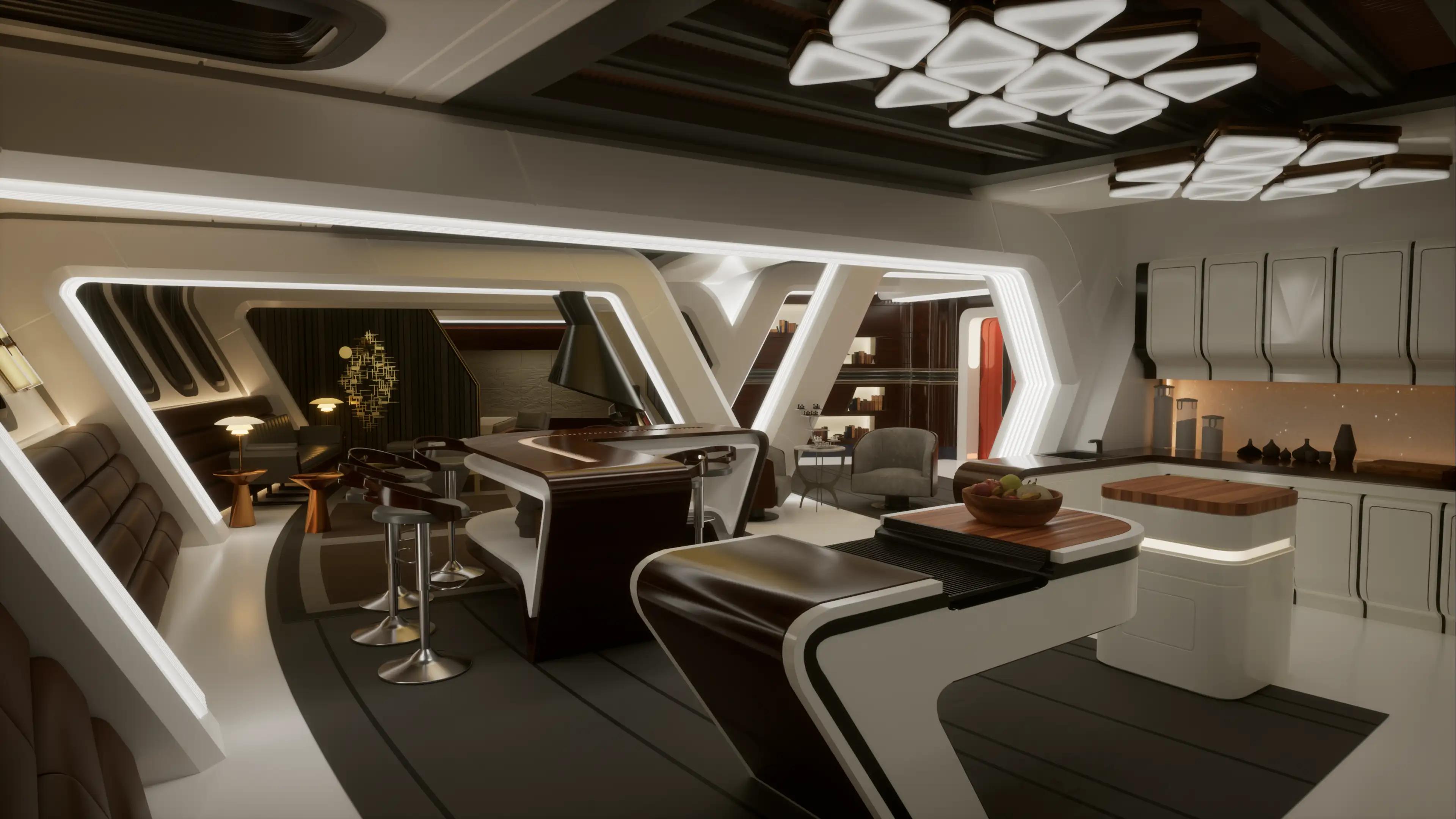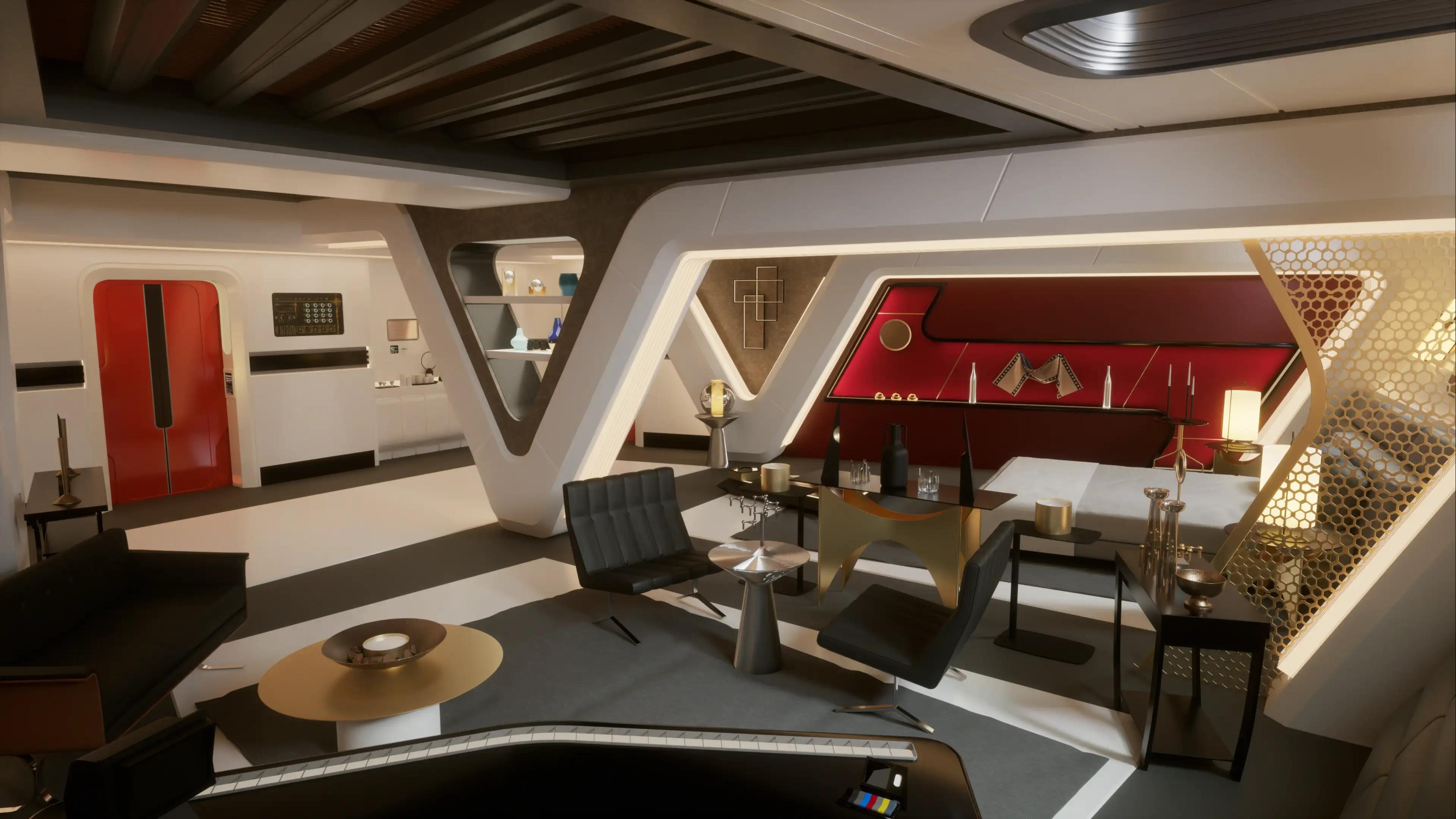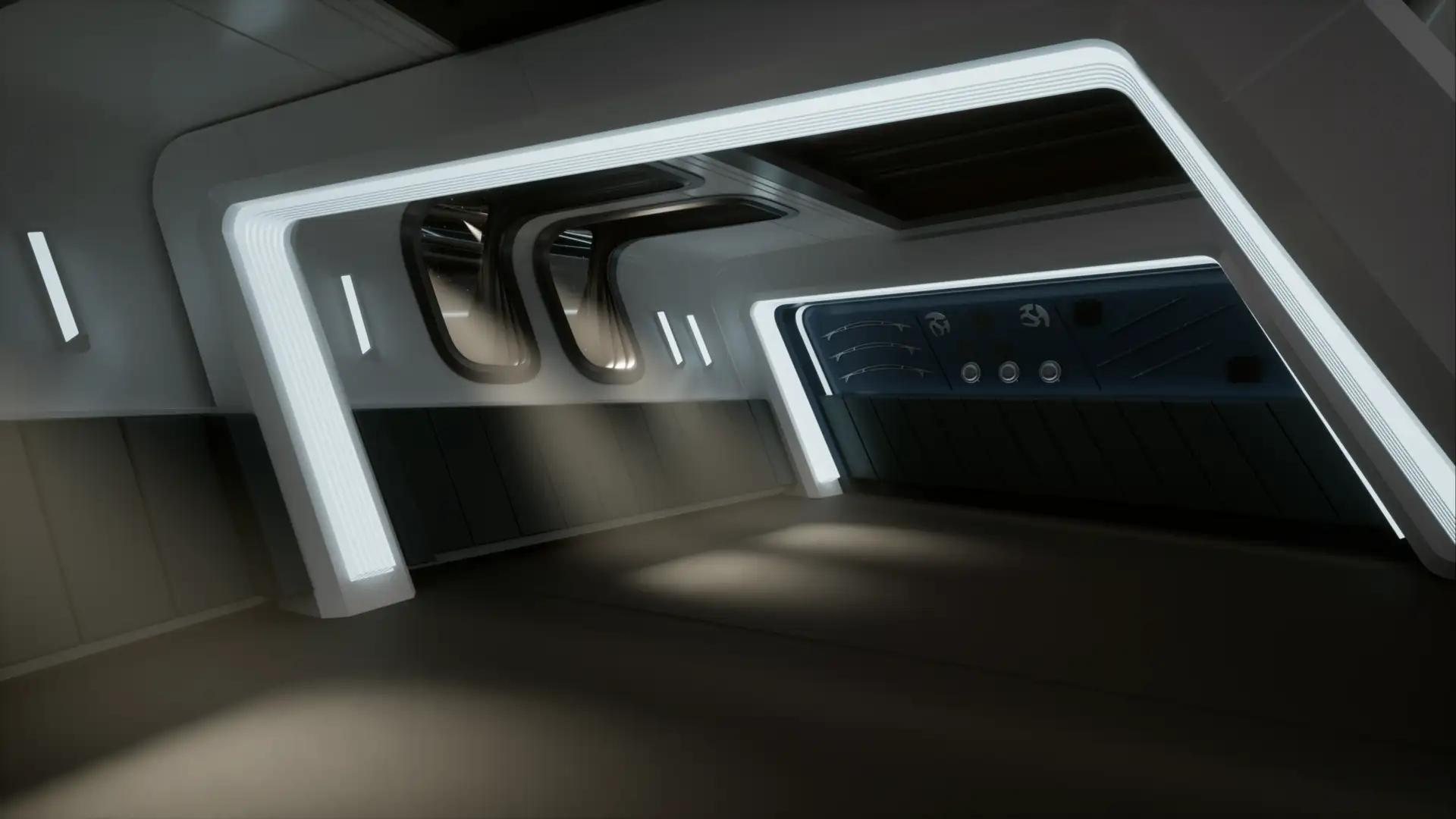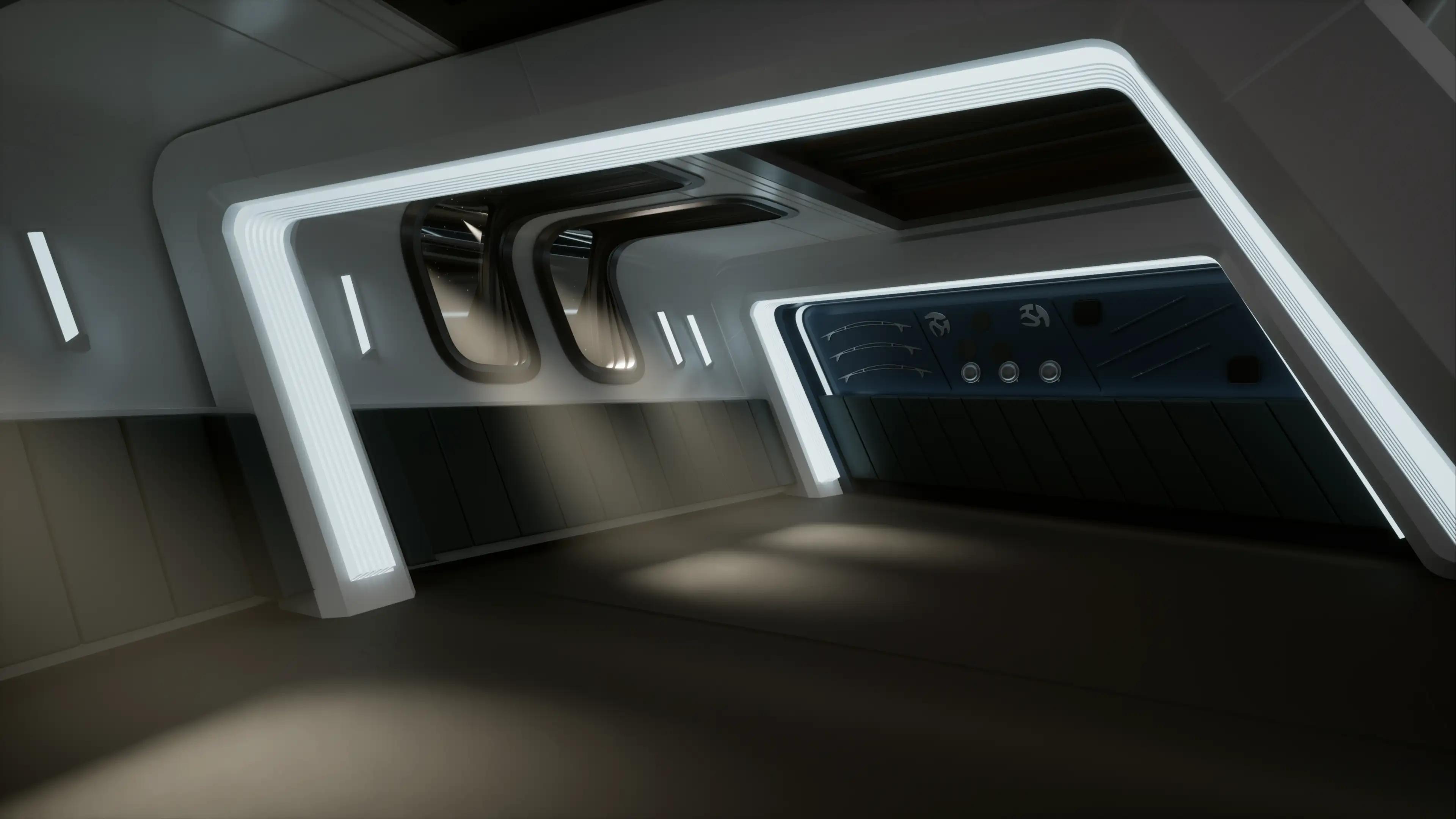U.S.S. Enterprise NCC-1701 (2259)
U.S.S. Enterprise NCC-1701 (2259)


The U.S.S. Enterprise NCC-1701 was a Constitution-class vessel launched in 2245 that was commanded by Captain Christopher Pike from 2250 until 2265. It was the first Federation starship to bear the name Enterprise and one of the most storied starships in Federation history.
U.S.S. Enterprise Bridge | Deck 1 (2259)


The bridge of the U.S.S. Enterprise was circular in shape with a wide viewscreen/window combination at the forward end of the bridge. The captain’s chair was placed centrally, slightly towards the rear, with the helm and navigation stations directly in front at a lower elevation. Five additional duty stations adorned the outer perimeter of the bridge, critical for carrying out ship operations. Access to both a turbolift and the conference room were available at the rear port and starboard sides of the bridge, respectively.
U.S.S. Enterprise Pike’s Quarters | Deck 5 (2259)


Pike's quarters on the U.S.S. Enterprise exemplified his multifaceted persona and interests. Pike was an avid cook, host, and cultural explorer. His quarters featured a kitchen, a dining table, a fireplace, and a hydroponic garden. He also displayed a plethora of artifacts and art from his voyages. Pike's quarters were a cozy and hospitable space, where he frequently invited his crew and friends for gastronomic and ludic experiences.
U.S.S. Enterprise Spock’s Quarters | Deck 5 (2259)


Spock's quarters on the U.S.S. Enterprise were a reflection of his dual heritage and his quest for balance. The room was spacious and minimalist, with large windows that offered a view of the stars. Spock had a few personal items that reminded him of his Vulcan and human origins. He also had a meditation alcove where he could practice his mental disciplines and connect with his inner self. Spock's quarters were a place of peace and harmony, where he could explore his emotions and logic in equal measure.
U.S.S. Enterprise Transporter Room | Deck 6 (2259)


The transporter room was a marvel of 23rd-century engineering. It was a critical hub for crew members to beam to alien worlds or ships. The room blended mid-century aesthetics with futuristic elements, reflecting the ethos of exploration and discovery. The room housed the iconic transporter pad and an added corridor that facilitated movement, embodying the fluidity of space travel.
U.S.S. Enterprise Training Quarters | Deck 6 (2260)


Adhering to the architectural consistency of the crew quarters, this specific room was intentionally left uncluttered to maximize space for combat training. The side walls were equipped with an array of weapons and tools, which provided crew members the opportunity to enhance their proficiency in various combat techniques. This strategic design ensured that the crew was well-prepared for any potential combat scenarios that may arise during missions. The room thus served as a practical and versatile space for skill development, reinforcing the crew’s readiness for diverse challenges.
U.S.S. Enterprise Main Engineering | Deck 18 (2259)


Located on deck 18 of the U.S.S. Enterprise, main engineering is a massive, multi-level chamber with expansive views of the ship’s engines and warp core. The work area for the crew is a raised platform with a guard railing overlooking the engine core. In the center of the room is the intermix chamber, a stove-like cylinder rising up to the ceiling that contains dilithium loading ports, where pulsating energy can be seen thrumming through the chamber’s transparent shaft. The primary workstations for the engineering crew are found on a 3-pronged console; an additional control console is located affixed to the railing, with a handy workbench nearby. Ringing the room are access points for the “Jefferies tubes” (the maintenance shafts of the Enterprise), crew entry doors,and turbolift access.
PRODUCTION INFO
Ship Model (Digital)
As portrayed in Star Trek: Strange New Worlds - “Strange New Worlds” (TV, 2022)
The digital model of the U.S.S. Enterprise featured in Strange New Worlds remained primarily the same as its appearance in Star Trek: Discovery, save for a few cosmetic differences, including the placement and shape of some of the ship’s windows to match the windows featured in new interior sets built for the series.
Bridge Set (Physical)
As portrayed in Star Trek: Strange New Worlds - “Strange New Worlds” (TV, 2022)
The bridge of the U.S.S. Enterprise was slightly modified from its reintroduction in Star Trek: Discovery for its appearance in Star Trek: Strange New Worlds by the series production designer Jonathan Lee. In contrast to its previous appearance in Discovery, the bridge was lit with a warm lighting scheme for its Strange New Worlds appearance, among other cosmetic modifications.
Pike’s Quarters Set (Physical)
As portrayed in Star Trek: Strange New Worlds - “Children of the Comet” (TV, 2022)
The set of Pike's quarters in Star Trek: Strange New Worlds was a blend of retro and modern design. The production designer, Jonathan Lee, wanted to pay homage to the original Star Trek series, but also update it for the 2020s. He used custom-made furniture and 1960s brutalist art to create a cozy and stylish space for the captain. The set reflected Pike's personality and his role as leader of the U.S.S. Enterprise crew.
Spock’s Quarters Set (Physical)
As portrayed in Star Trek: Strange New Worlds - “Spock Amok” (TV, 2022)
While the crew quarters in Star Trek: Strange New Worlds maintain a consistent architectural framework, each room was uniquely tailored to mirror the character and narrative arc of its occupant. For instance, Spock’s quarters incorporated several design elements reminiscent of the original Star Trek series, most notably the central dividing wall. Despite the familiarity of Spock’s quarters from previous series, the Strange New Worlds rendition represented a modern refit, reflecting advancements in technology and increased production budgets characteristic of the 2020s. This approach ensured both continuity and innovation in set design.
Transporter Room Set (Physical)
As portrayed in Star Trek: Strange New Worlds - “Strange New Worlds” (TV, 2022)
The transporter room was a blend of iconic elements and modern updates. Production designer Jonathan Lee was responsible for the design. He added a corridor around the back of the transporter room to allow for easier camera movement. The design was similar to the original Star Trek series, with Lee ensuring that his favorite elements made the cut. The transporter room, like other parts of the ship, reflected a balance between mid-century aesthetics and contemporary science fiction futurism.
Training Quarters Set (Physical)
As portrayed in Star Trek: Strange New Worlds - “Tomorrow and Tomorrow and Tomorrow” (TV, 2023)
The training quarters was a simple redress of the set used for the various crew quarters seen throughout the U.S.S. Enterprise in Star Trek: Strange New Worlds.
Main Engineering Set (Physical/Digital Hybrid)
As portrayed in Star Trek: Strange New Worlds - “Strange New Worlds” (TV, 2023)
The U.S.S. Enterprise main engineering set seen in Star Trek: Strange New Worlds is a synthesis of practical set design and the possibilities achievable with the use of the high-tech LED volume stage. The set is one of 10 Enterprise sets built for ST: SNW by production designer Jonathan Lee and his 60 person design team, consisting of a foreground practical set with workstation consoles, bounded by a guard railing. Sweeping around this foreground are the walls of a 70'x30' horseshoe-shaped LED volume stage, featuring virtual environments built by teams of artists using Epic’s Unreal Engine technology. The decision to incorporate an LED volume stage both simplified the build of the practical set and hugely expanded the possibilities of visualizing the scale and scope of the inner workings of the warp engine.
Over the course of building the virtual environment, teams of virtual production artists continually liaised with the series’ lighting designers, directors, set designers and directors of photography to align and adjust the developing virtual space to flow seamlessly with the “real” elements of the set. The team eventually developed 4 separate “baked” lighting scenarios: “baked” lighting refers to pre-programmed looks, such as “Meltdown” or “Red Alert”. By combining one of these “baked” lightmaps with animated 3D color correction, the production is able to create pulsing light throughout the room which conveys that energy is mixing within the warp core.
Before shooting begins, the virtual artists have a “blend” day, loading in the virtual background and adjusting its lighting to match the real foreground where the actors will be. On the day of shooting, small adjustments are made during the shoot in consultation with the rest of the on-set production team. This method allows the actors to interact with and respond to the virtual environment, allowing for a more natural performance and a sense of lived-in dynamic realism.